If you have had the good fortune of trying fresh, homemade German sauerkraut, you'll know it tastes so much better than store-bought canned varieties. It is crunchy, slightly acidic, yet sour, and full of flavor.
Luckily, making your sauerkraut at home is incredibly simple, and doesn't require much in the way of supplies, or ingredients. You actually only really need two ingredients!
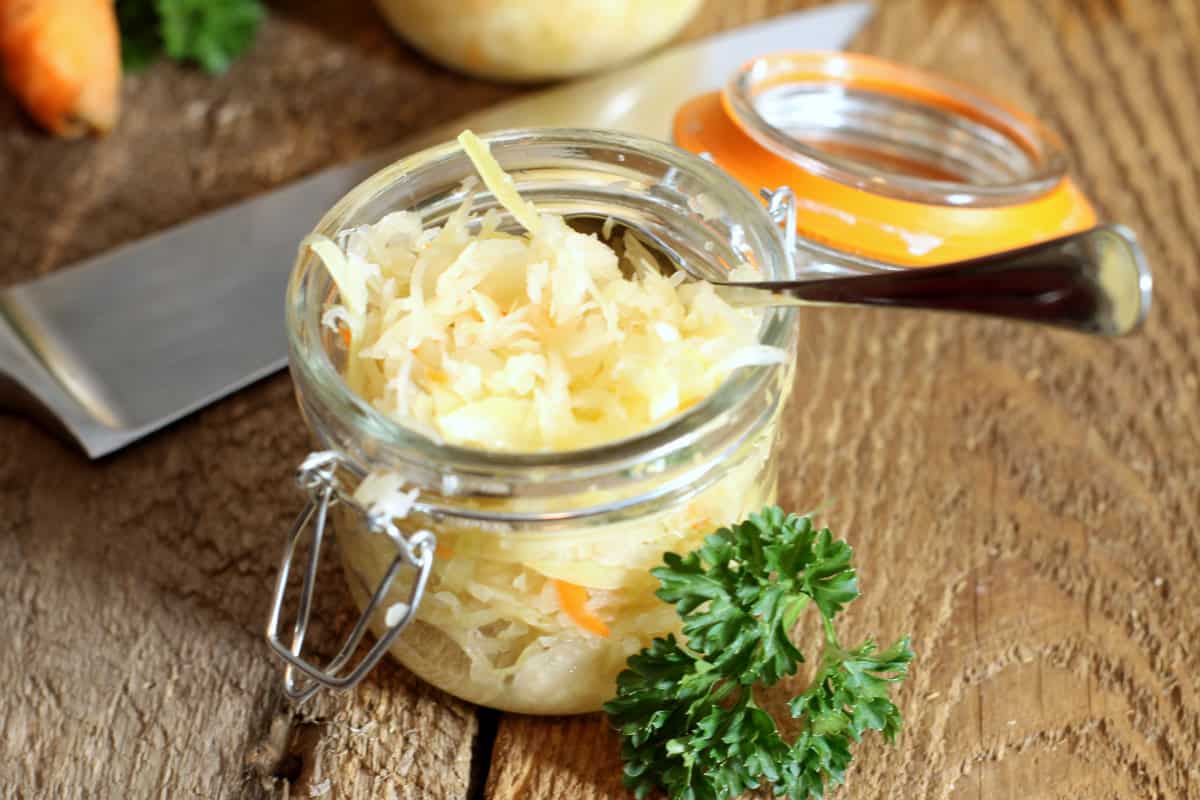
This post contains affiliate links for which we may be compensated if a purchase is made through the links provided at no extra cost to you. For more information, please read our affiliate disclosure.
Table of Contents
The basics - How is sauerkraut made?
In its most basic form, sauerkraut is made by mixing raw cabbage and salt to create a natural brine, which then ferments the cabbage through a process called lacto-fermentation.
Fermentation helps preserve the cabbage for long-term storage and prevents the growth of mold and bacteria that would otherwise make the cabbage go bad.
The great thing about this type of natural fermentation is that it does not destroy any nutrients in the vegetable itself, creating a nutritious fermented product full of vitamin C , probiotics, and enzymes beneficial to your health.
Other vegetables can be fermented in this way as well such as carrots, beets, or turnips preserving their taste, and texture.
What Is Lacto-Fermentation?
Lacto-fermentation is the process of thousands of tiny live beneficial bacteria (specifically Lactobacillus), that work to convert the natural sugar present in cabbage, into lactic acid creating an environment void of bad bacteria.
Lacto-fermentation has been used for thousands of years to naturally, and safely preserve foods, and increase your overall health. A battle between good and bad bacteria, lacto-fermentation requires only three ingredients to do its job:
- Salt
- Water
- and your vegetable of choice.
How does lacto-fermentation work?
First, the cleaned vegetable of choice is mixed with salt in a non-reactive container (such as a specialized glass jars, or in a specialized stone crock), creating an environment unsuitable to bad bacteria.
These bad bacteria would otherwise spoil food and make us sick if they were allowed to multiply. The salt helps draw out the natural water in the present in the vegetable creating a brine in which the fermented food is kept.
After all the bad bacteria have died off, live Lactobacillus bacteria which is naturally present in most foods, gets to work, converting the natural sugars into lactic acid, thereby preserving the vegetable.
The process of lacto-fermentation can take anywhere from 2 to 3 weeks to complete depending on the temperature the fermentation container is kept at. In warmer conditions, the bacteria will work faster than in cold temperatures.
While the fermented product will keep fermenting even once the desired acidity is achieved, the fermented food is usually placed in a cold or refrigerated spot to slow down the fermentation process once the desired taste is achieved.
Make your own German sauerkraut.
To make your own German sauerkraut you only need two ingredients and a fermentation vessel. Stone fermentation crocks work beautifully, and come in two styles.
Those with a water lock, and open fermentation-style containers. Which you choose is entirely up to you, but both work on the same principle that the cabbage is submerged in brine using a weight of some kind and then fermented for extended periods of time.
The only real difference is that the water lock-style containers have a special lid that creates an anaerobic environment, only allowing the gas from the fermentation process to escape, but no air can enter back into the vessel.
Ingredients
To make your sauerkraut you really only need two ingredients, salt and cabbage, (though we are adding a third here for color!).
Any cabbage can be used, but in general regular green cabbage is the most commonly used variety.
The amount of salt you need to make sauerkraut is determined by the amount of cabbage used. You want to aim for a salt content of 2% of the weight of the cabbage. So for the 2 kg of cabbage we use here, you'll need about 40 grams of salt.
Make sure the salt is iodine free, pickling salt is my go-to option.
For our small batch of sauerkraut (which fits in a 1.5 l glass mason jar), we used:
- 1 large head of green cabbage (roughly 2 kg or 4.5 lbs of cabbage)
- 40 grams of salt
- 1 shredded carrot - to add some color to the sauerkraut
If you are using a larger 1 gallon or even 5 gallon stone crock you'll need to use more cabbage. For a 1 gallon stone crock, you'll need about 3 - 4 lbs of cabbage.
Step-By-Step Instructions
Prepare the Cabbage
Start by removing the outside leaves of the cabbage and the core. To do this, cut the head of cabbage in half, and then into quarters. I have found this to be the easiest way to remove the core. Cut out the core sections and discard them.
Next cut the cabbage into small strips or a roughly chopped square shape. How small you cut the cabbage is ultimately up to you.
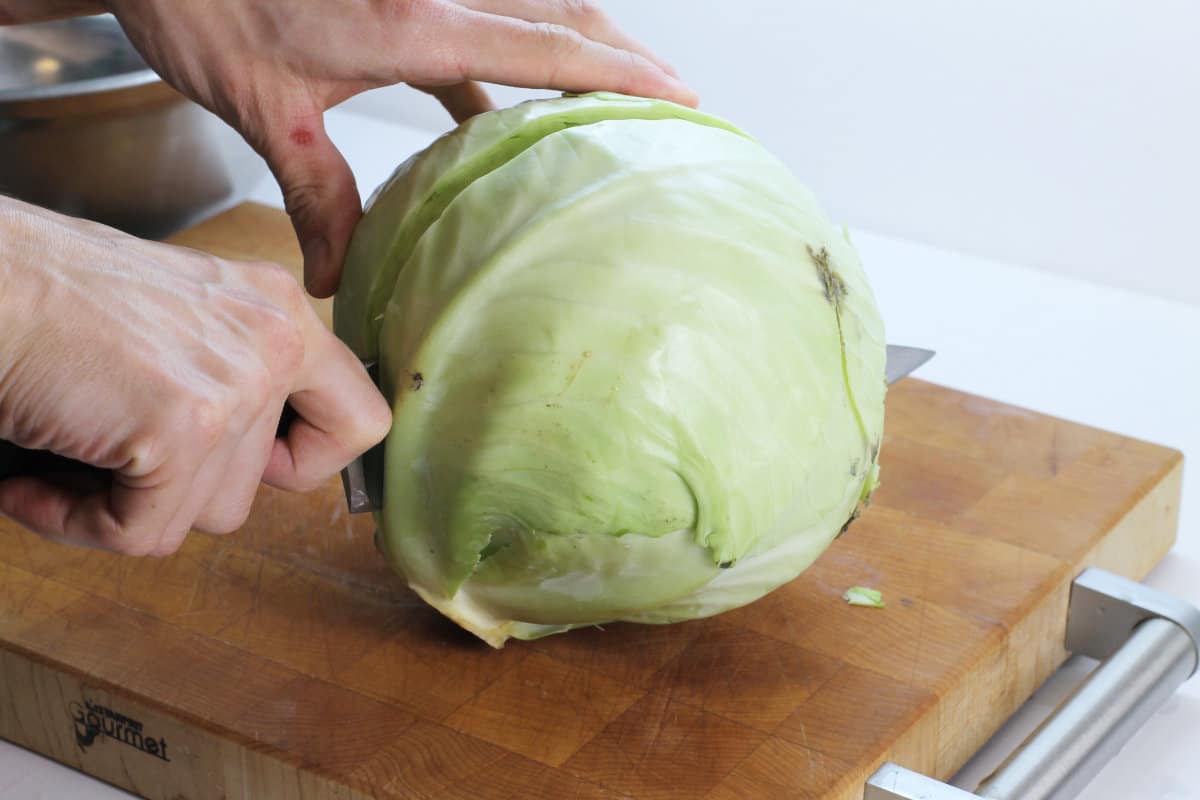
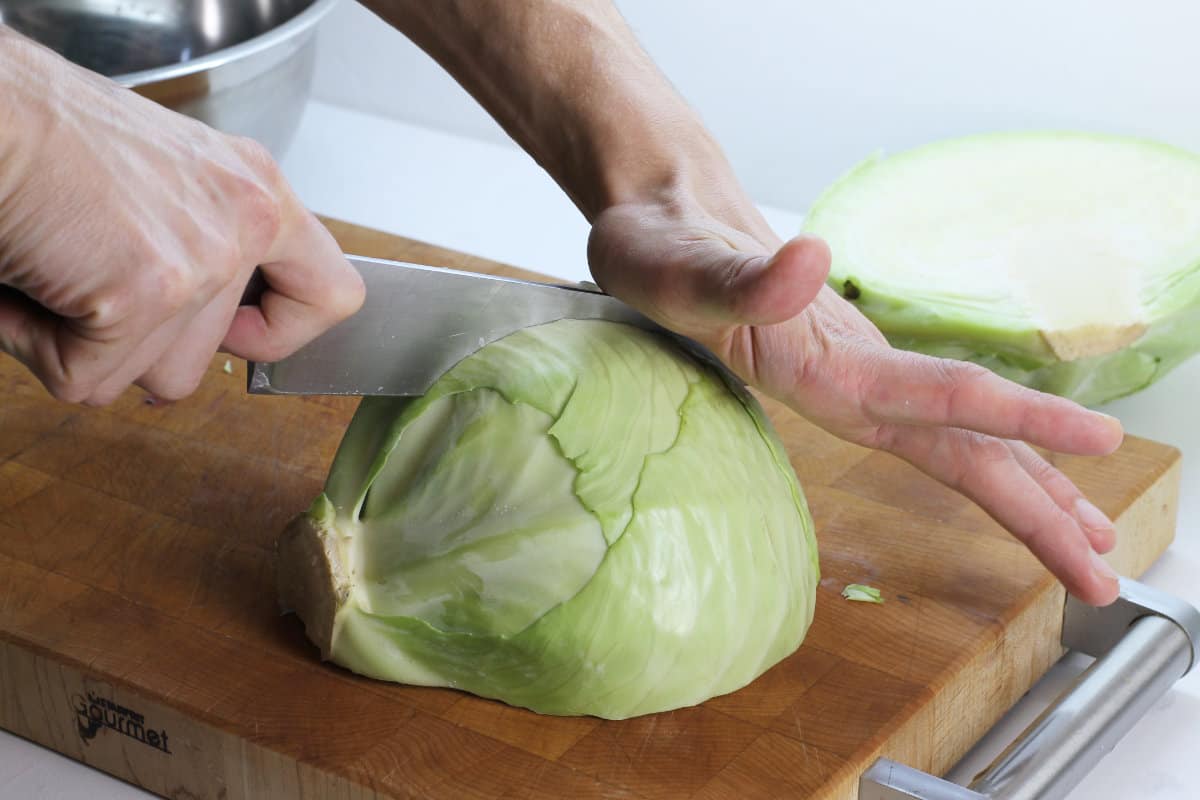
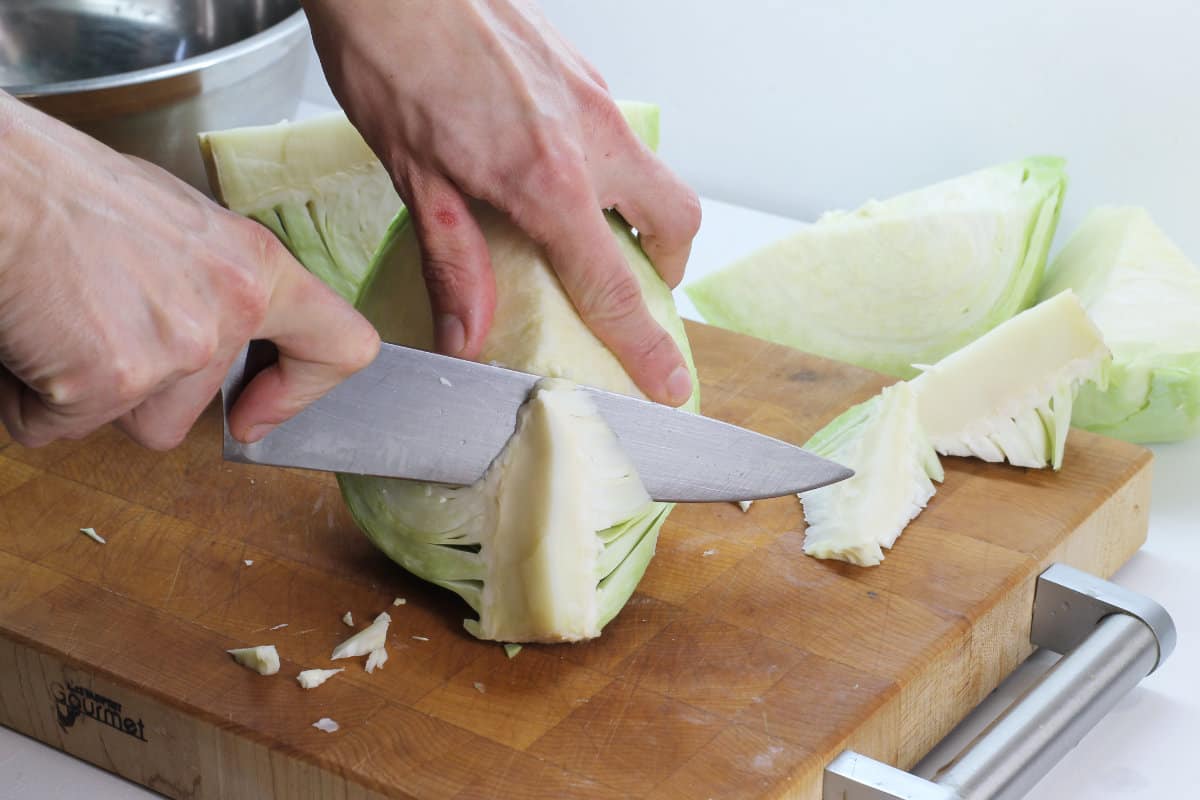
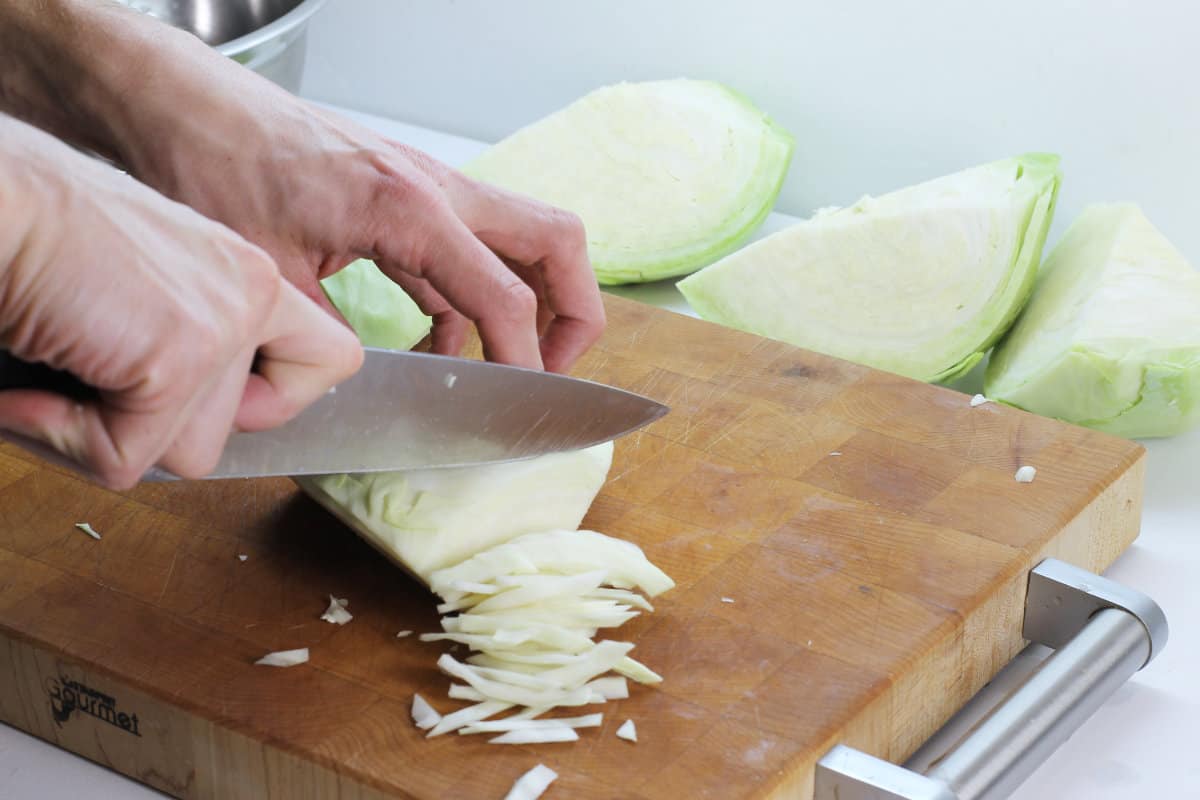
The easiest way to 'shred' the cabbage when making homemade sauerkraut is to separate the quartered cabbage into "stacks" and then, using a very sharp chef's knife, julienne the cabbage.
The cuts don't need to be perfect, but you do want the cabbage to be somewhat uniform in size. This helps create a more appealing texture and easier-to-eat end product!
Once all of the cabbage is cut to your satisfaction, dump it all into a large bowl or bucket. This is not the final container you will ferment/store the sauerkraut in.
Mix in the 40 grams of salt and thoroughly mix it in with your hands. At this point in the process, many recipes will call for adding water or brine, but this is unnecessary with our method.
While you do need liquid to submerge the cabbage, you can extract enough natural water present in the cabbage by pounding it with the salt mixed in. The pounding action and the salt work together to release the water creating the brine needed to lacto-ferment the sauerkraut.
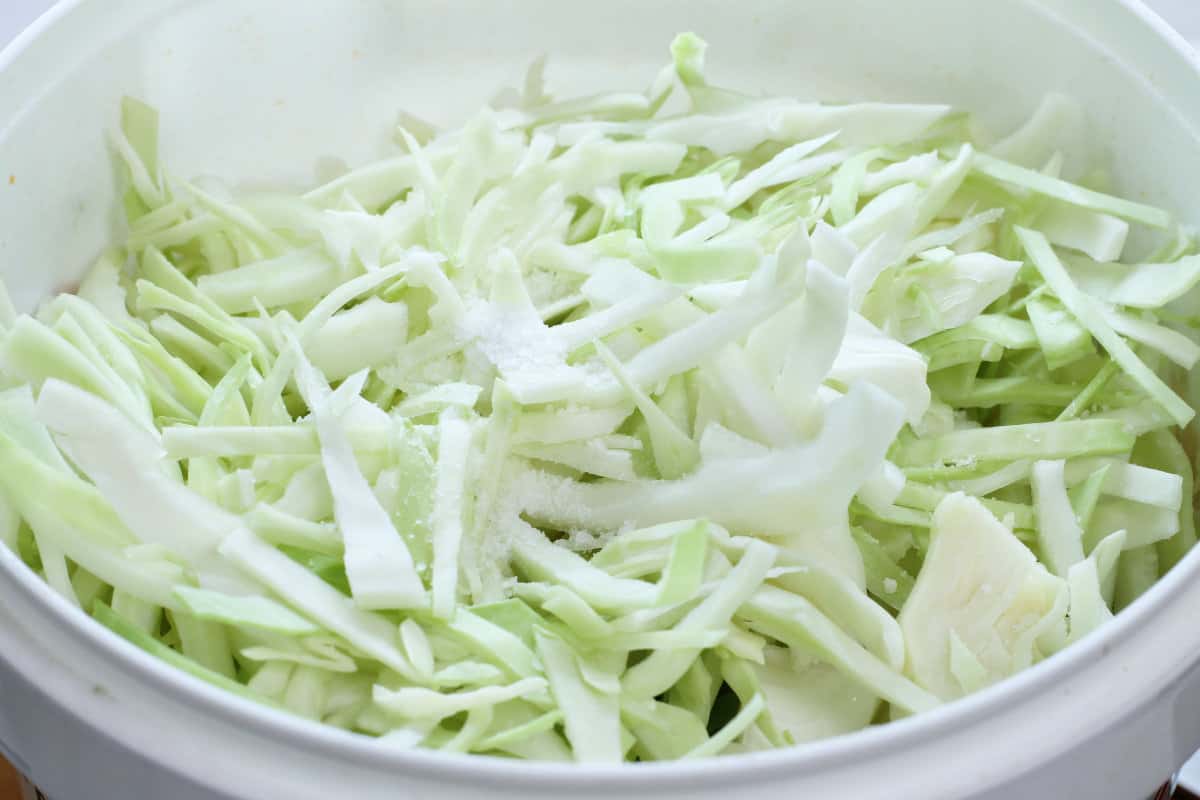
You can use a specialized tool called a pickle packer, fashion your own stamper out of wood, or use anything else you may have around the house as long as it's cleaned first of course! I have in the past used an empty wine bottle (though I must admit I was worried about it breaking), and as you can see in the pictures here a meat mallet does a fine job!
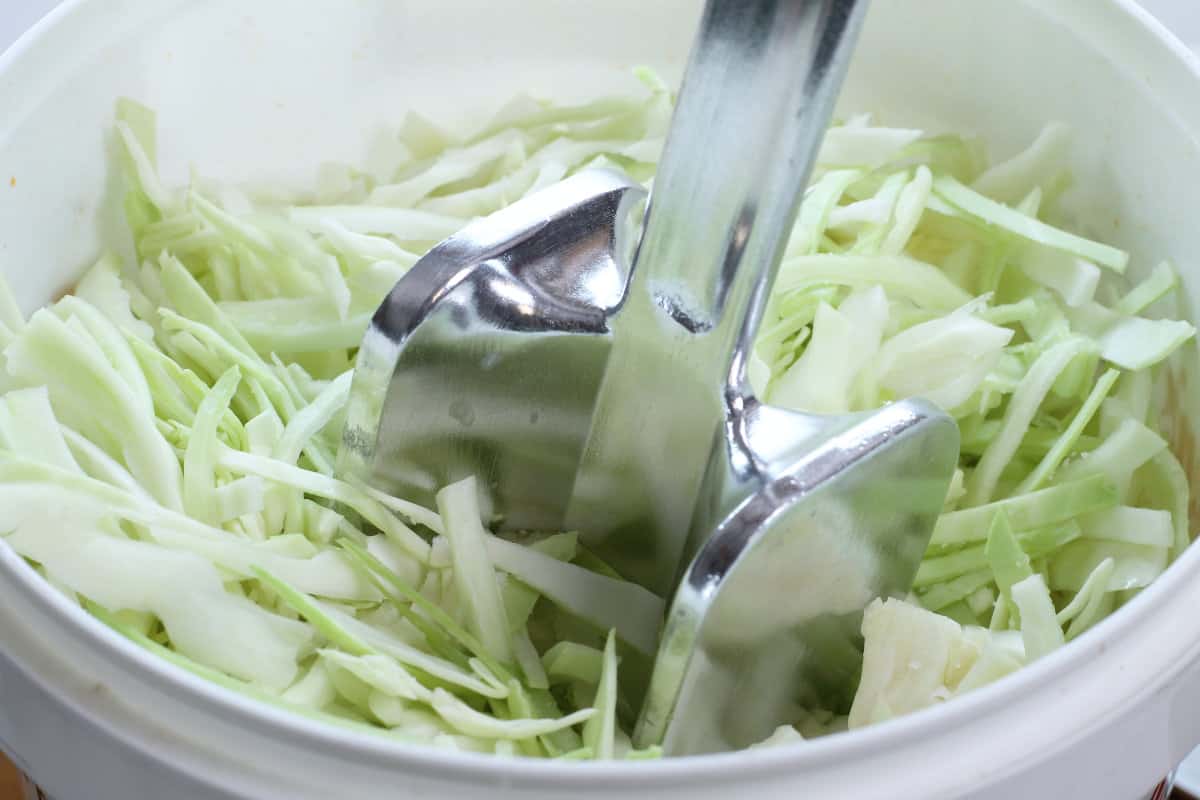
Expect to stomp your cabbage and salt mixture for a good twenty minutes before you have enough liquid to submerge the cabbage in. You will know you are done stomping when you can push the cut cabbage down and the liquid brine rises up covering the surface of the cabbage.
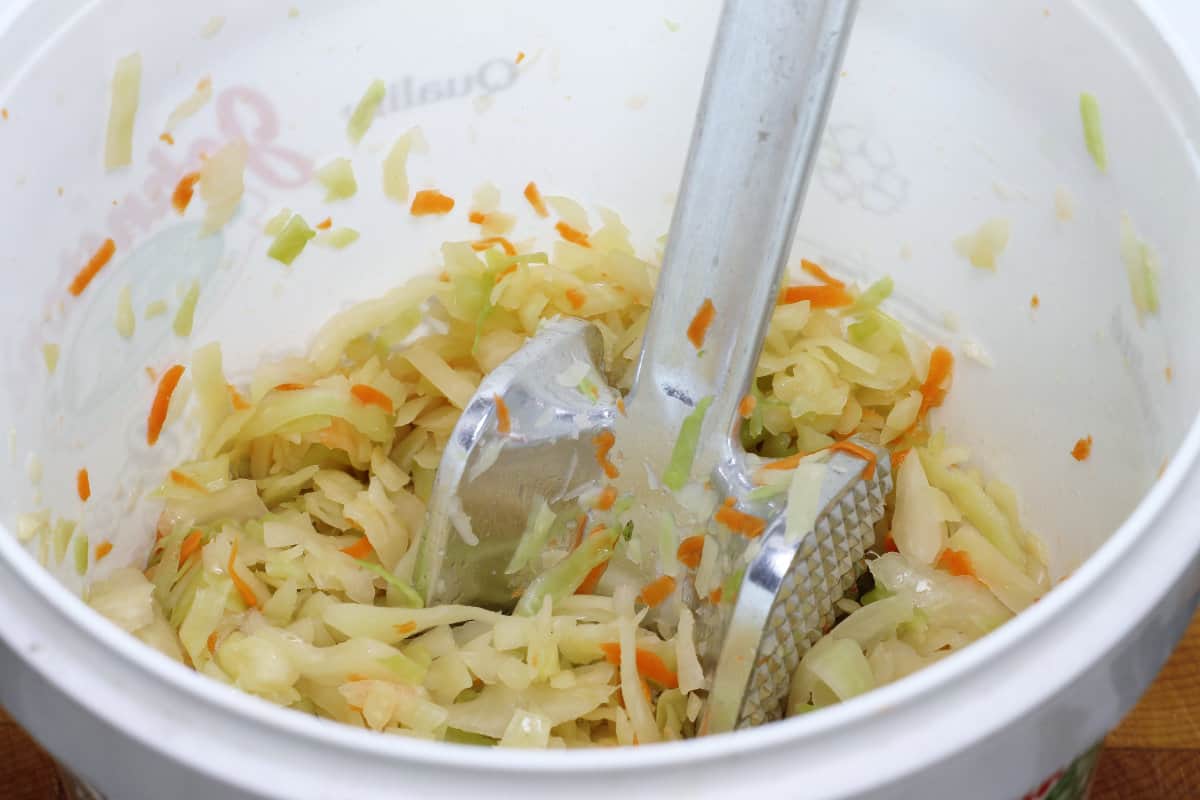
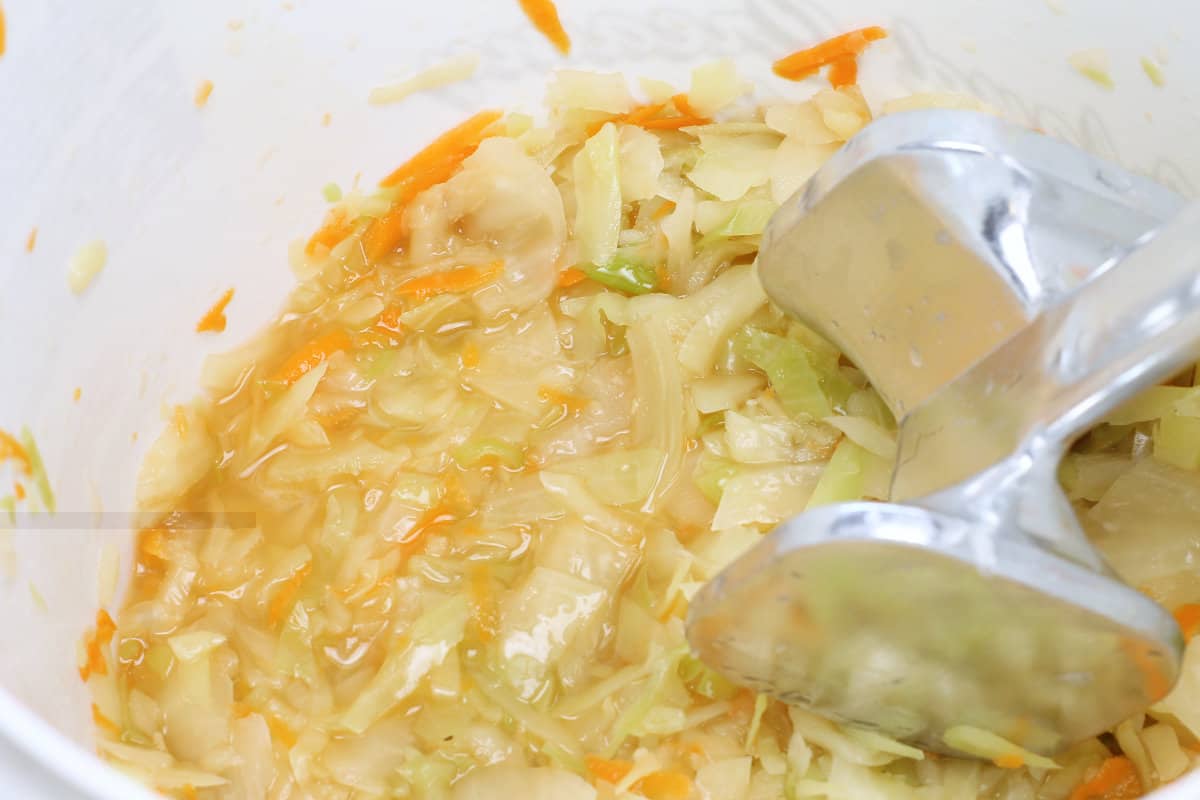
You'll notice in the above image that I have added a shredded carrot to my cabbage. I like adding one carrot in to add color and some visual appeal. It will not noticeably change the flavor of the sauerkraut. - Chef Markus Mueller
Once the cabbage can be pressed down and submerged under its own liquid, the hard part is done. Pack the sauerkraut into your final fermentation jar or vessel, and place a weight on top of the sauerkraut to keep it submerged in the liquid brine.
As I generally make small batches like this one (instead of 10-20L at a time as you would in a large stone crock), I use a clean glass bottle filled with water as my weight. Wine bottles work great and just fit inside the mouth of the 1.5L mason Jar.
Otherwise, these mason jar fermentation lids are cheap and work splendidly!
Fermenting The Sauerkraut
After two or three days you should start to see some foam and a little bubbling action on the surface of the liquid. This is a good sign and means that the good bacteria (the Lactobacillus) is starting to do its job, converting naturally present sugar into lactic acid!
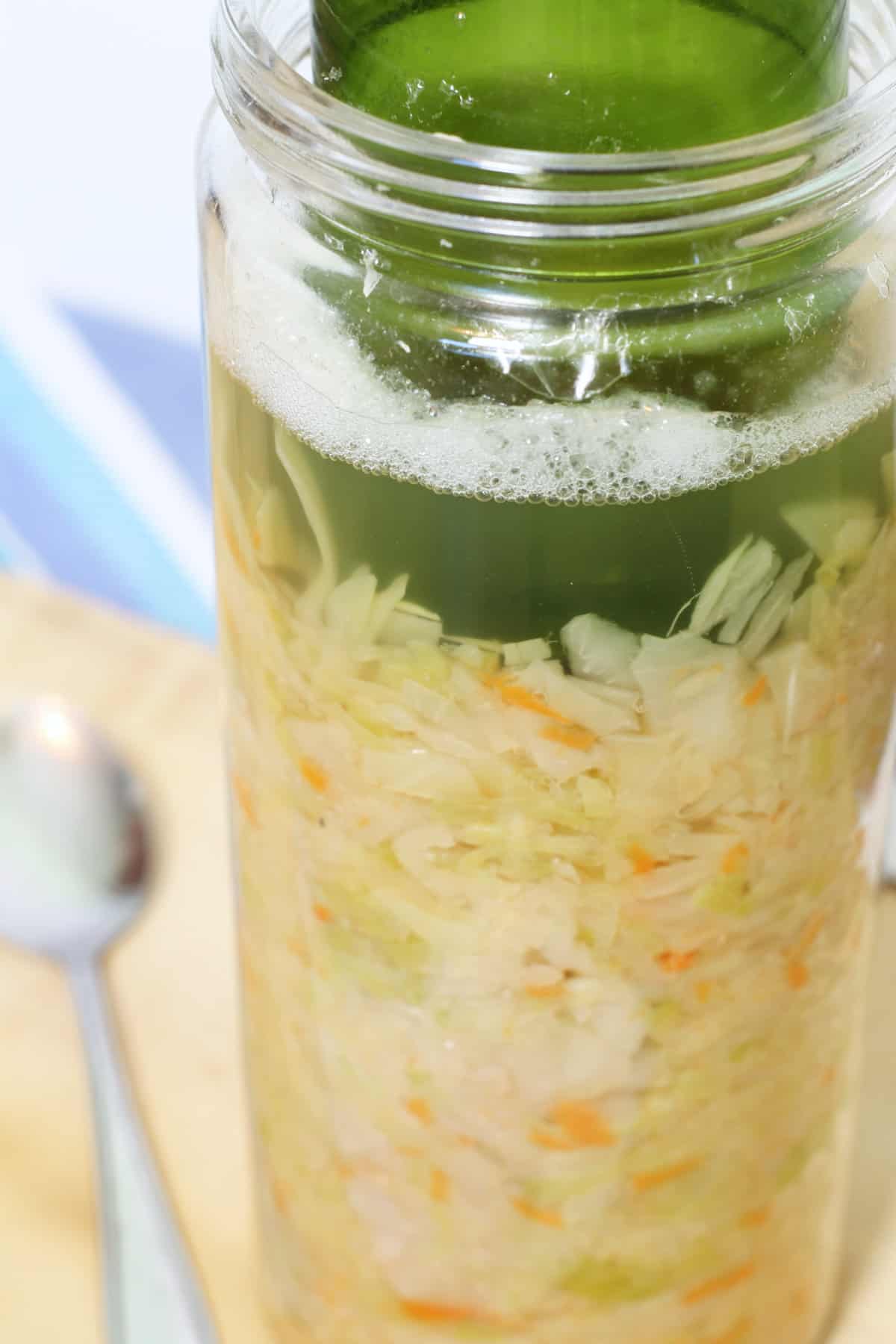
Your sauerkraut is now starting to ferment! Ferment the cabbage for 2 to 3 weeks, taking a small taste test at the two-week mark to check the flavor and acidity.
Troubleshooting
- If you see mold starting to grow on the sides of the jar ABOVE the liquid, simply wipe it away with a clean cloth. This may happen since brine may splash up on the sides of the container as you are filling it creating spots for mold to feed on. Rest assured that anything submerged in the brine will be safe to consume!
- If you don't see any bubbles or frothing, this is ok. Lacto-fermentation is not as active as say winemaking can be. Let the sauerkraut sit for 2 to 3 weeks and simply ensure the liquid stays above the cabbage, completely submerging it.
- If your brine starts to evaporate, you can add fresh water to the fermentation vessel to top it up. As only the water evaporates and the salt stays behind, do not top up with brine as you will increase the salt content.
How to store your German sauerkraut.
Once the sauerkraut has reached the desired amount of acidity, pack the kraut into smaller jars (with brine), and refrigerate, or move the entire fermentation vessel into a cold location such as a cold garage, porch, or cold cellar. This will slow down fermentation and also help keep the sauerkraut tasting fresh.
Refrigerated, the homemade sauerkraut will easily keep for 3 months, but you may find it gone long before then!
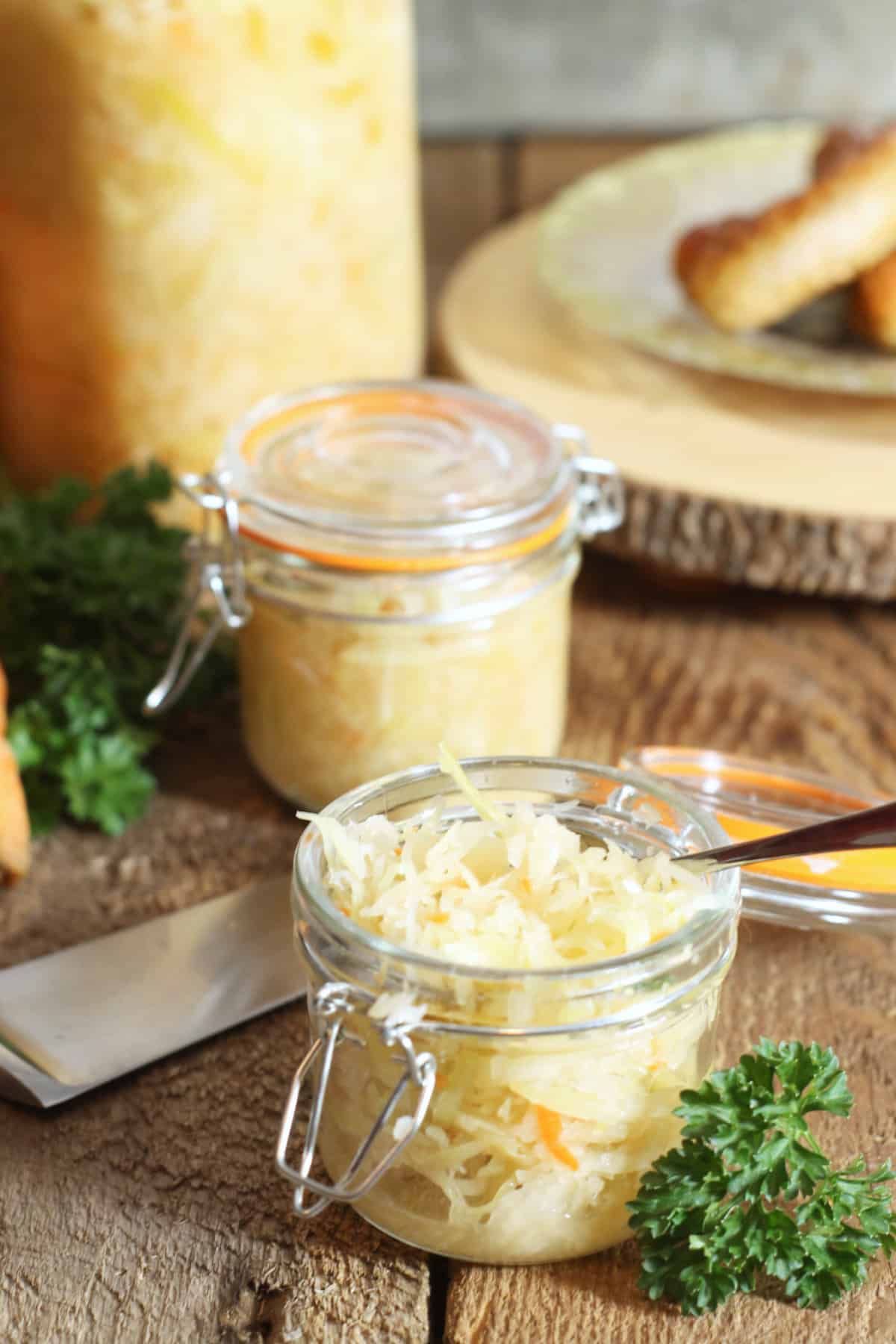
What do you eat sauerkraut with?
Growing up with a German background, I was inevitably introduced to sauerkraut by my father who loves the stuff and will eat it on anything! It goes to show just how versatile good sauerkraut can be, especially when eating on a budget, or wanting to preserve cabbage you grew in your own backyard.
Sauerkraut can be eaten cold on sandwiches (think in a bun with an Oktoberfest Sausage), as a side to a hearty meal, or simply on its own for a refreshing and healthy snack. It can also be eaten hot, and is delicious sauteed with onions and bacon, creating a slightly sour vegetable side dish great with a pork roast, or red meat!
Looking for more cabbage dishes? Try this blueberry braised red cabbage!
More German Recipes
If you loved this German recipe, try out some of my other traditional German foods such as these:
- Hearty German Goulash
- German Schnitzel
- Jägerschnitzel (Hunter's Schnitzel)
- Braised German Red Cabbage Recipe (Rotkohl) with Blueberries & Cloves
- German Meat Fondue (Fleischfondue)
- Spaetzle Noodles
- Käse Spaetzle with Caramelized Onions (The Ultimate Mac & Cheese)
- German Glühwein - German Mulled Wine
- German Cucumber Salad - Gurkensalat
- German Rosinenbrot (Raisin Bread)
- German Sugar Candied Almonds (Gebrannte Mandeln)
- or my Grandmother's Apple Pie!
Made the recipe? Comment & Rate it below, then take a picture and tag me on Facebook. For more from scratch recipes, follow me on Facebook & Pinterest.
Recipe
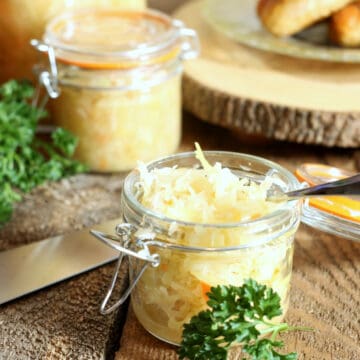
How To Make German Style Sauerkraut
Ingredients
- 2 kg green cabbage shredded
- 40 grams pickling salt
- 1 whole carrot shredded
Instructions
- Clean and quarter the cabbage, then remove the core. Peel the carrot. Shred the carrot and cabbage or cut into desired size.
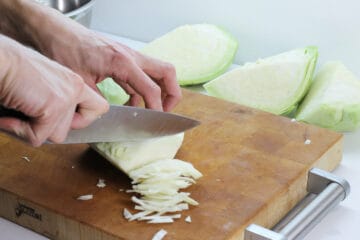
- Mix the pickling salt and shredded carrot into the cabbage.
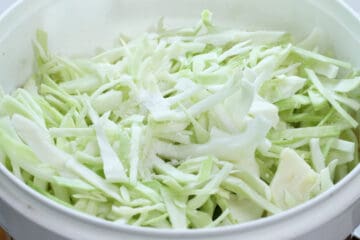
- Pound the cabbage mixture until there is about 1 inch of liquid, enough to cover the cabbage when it's pressed down.
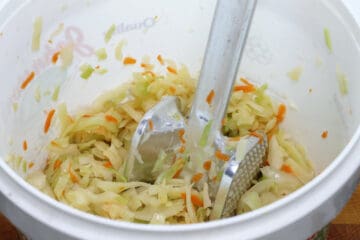
- Place a weight on the cabbage to submerge it in the brine, and store in a cool, dark area for 2 to 3 weeks to ferment.
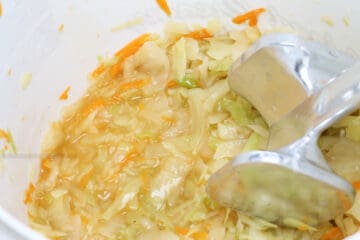
- Check the cabbage daily to asses fermentation and remove any possible mold growth.
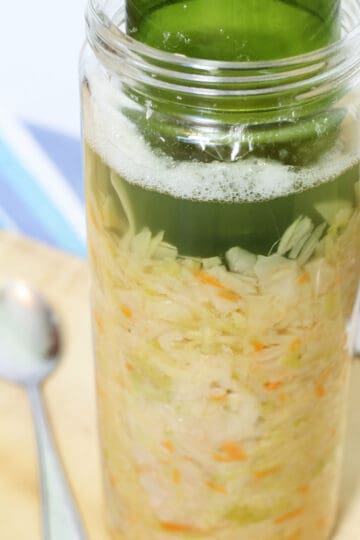
- Store fermented sauerkraut in mason jars in the fridge for up to 3 months after fermentation is complete.
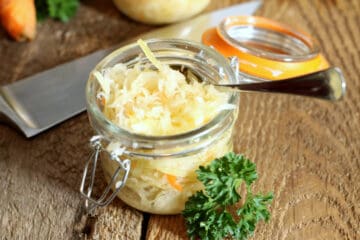
Notes
- If you see mold starting to grow on the sides of the jar ABOVE the liquid, simply wipe it away with a clean cloth. This may happen since brine may splash up on the sides of the container as you are filling it creating spots for mold to feed on. Rest assured that anything submerged in the brine, will be safe to consume!
- If you don't see any bubbles or frothing, this is ok. Lacto-fermentation is not as active as say wine making can be. Let the sauerkraut sit for 2 to 3 weeks and simply ensure the liquid stays above the cabbage, completely submerging it.
- If your brine starts to evaporate, you can add fresh water to the fermentation vessel to top it up. As only the water evaporates and the salt stays behind, do not top up with brine as you will increase the salt content.
Nutrition
Nutrition info is auto-generated. This information is an estimate; if you are on a special diet, please use your own calculations.
This post contains affiliate links for which I may be compensated if a purchase is made through the links provided. For more information please read my affiliate disclosure.

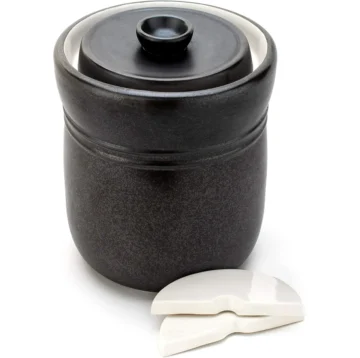

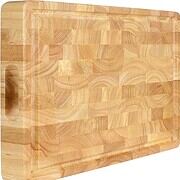
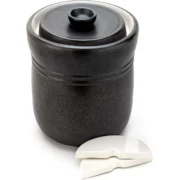
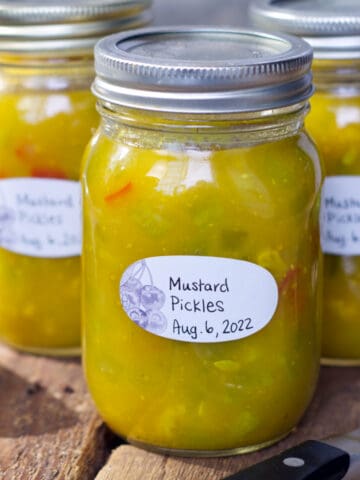
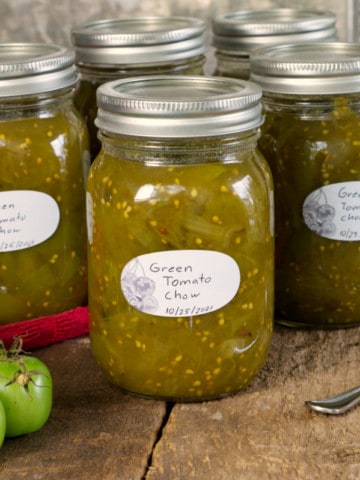
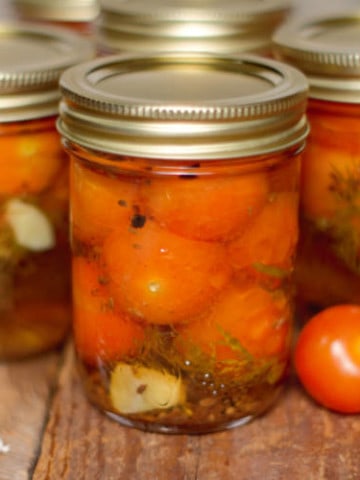
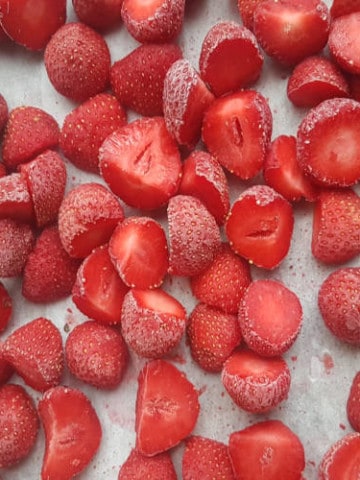
MJ Rowlandson
Hello Markus: I am what people would call a late life child to my parents. When I was born both sets of grandparents had already passed on. As a child around 4-5 years old I remember in the fall the big crock pots (some were taller than me) sitting out back in the old summer kitchen brewing. Mom had them filled to their brims with pickles, sauerkraut and all sorts of yummy things for the winter season (lol it was really stinky out there, I was only 4 -5 yrs old after all). But, unfortunately by the time I was old enough to start really remembering and learning the old school art of the "how-to craft" of preserving and canning my mother had passed on. I'm a complete newbie to the canning process. Sauerkraut has been one of my favourite foods since childhood. A couple of years ago my husband gave me a complete utensil set of items to make homemade fermented foods (ie: sauerkraut) as a Christmas gift. LOL, I have yet to put these items to use. I have been doing research off an on for awhile on the subject of "how to ferment and can food items". There seems to be as many opinions as there are chefs out there as to the best way to proceed in food fermentation. To date your info listed above has been one of most expletive that I've come across (very much appreciated thank-you). However, all the info I've studied including yours says that a fermented product only last tops 3 months in a fridge. Though my very first thought after reading this article/recipe recommendations is this; why do you state the standard line of your recipe's finished product will only last for two - three months after it is canned, sealed and refrigerated? However; when you talk about your dad making a years worth of sauerkraut in one go. WOW! What is the difference between his process, your recipe above and most of the other posted recipes? Why does your father's finished product last for 10 to 11 months(assuming one - two months to ferment yearly batch)? I don't want the hassle of having to do a batch every three months or so. Is there something more to do/to add during the actual fermenting stage itself to add longevity to the fermented items? Yes, I'm aware the fermenting time period has its affect on quality of flavour but does a longer length of fermentation time also extend the shelf life without compromising taste to much and food consumption safety?
This fermenting process as you said has been around for thousands of years and in the beginning there were no grocery stores for people to buy their fresh carrots and cabbages from every couple of months as needed or refrigerators to store their finished canned products. How is the shelf life of fermented food extended to include a whole season of storage for use? Thank-you.
OH: You recommend a minimal top up of water if to much natural moisture/water evaporates during fermenting process in your "trouble shooting section". Then you recommended to a commenter not to do that (?) because of tap water contaminants?? Just asking for my own future reference. Your thoughts; do you think the use of bottled distilled water(with next to zero contaminants) could be used as a minimal fluid top up if really needed as opposed to tap water?
Chef Markus Mueller
Hi Mj, I'll try and answer all your questions as best as I can! The storage guideline of 3 months in the fridge is meant to protect all my readers from any potential food poisoning. As I have no control over how readers store their sauerkraut, whether or not they use clean containers and utensils to remove sauerkraut from the main batch, varying refrigerator temps, varying bacteria levels etc, there are simply too many variables that come into storing the kraut longer and I don't feel comfortable telling folks it will last forever.
That said, if properly stored in a dark, cool/even cold location (my fathers kraut freezes almost semi solid over the winter months sometimes) , kept under the brine with a weight, and covered with a breathable cheesecloth to keep out debris, the sauerkraut 'should' not go bad, it will just slowly keep fermenting. The brine is key here as it protects the kraut from any bad bacteria. Care still needs to be taken to prevent mold growth on the edges and sides of the crock, which can lead to spoilage long term. That said if at any point your sauerkraut smells off, is slimy, or looks weirdly colored, use the age old mantra 'if in doubt, throw it out'.
In regards to topping up the brine, I have recently updated the post to say, yes it can be topped up with fresh water. The key is not to use chlorinated city water, which can inhibit the fermentation process. If in the city where chlorinated water is standard in most taps, fresh bottled water should be fine.
I hope that answers your questions. If there is anything else I can help with please feel free to email me at [email protected]
Chef Markus
Gay McDonald
Hi Chef Markus, some time back, I found a recipe that included dried rose petals in sauerkraut. It's an amazing addition, and also looks nice. Just add around 2tbsp to your standard recipe. And, when serving, I sprinkled over some pomegranate. We love to eat it with Shio Koji Chicken Breast and a tomato salad
Chef Markus Mueller
That sounds delicious! I will have to try it!
Lee
I lived in Germany for quite a few years and loved the sauerkraut from the supermarkets. I remember the taste to be a bit vinegary and very slightly sweet and very moreish. Will this taste the same? Would I need to add any vinegar and/or sugar in to the recipe to re-create the flavours I remember and if so, when? I have bought some Polish sauerkraut from the UK supermarkets and it just doesn't taste the same or as nice as the German version I remember. I really want to try this and have it on a brotchen with frikadellen and remoulade, among other things ????
Chef Markus Mueller
Hi Lee, I would not add any vinegar or sugar to the recipe as it can adversly affect the fermention. The shredded carrot will add a small amount of natural sugar which will help flavor the end product. Homemade saurkraut and store-bought kraut will always taste slightly differently, as commercial brands add various ingredients to extend and guarantee freshness and shelf life to accommodate shipping, storage, etc. Our recipe uses only lacto-fermentation to naturally ferment the saurkraut. I would suggest giving the recipe a go as it is, and if you don't find it sour enough, you can let it ferment longer to achieve a more sour taste.
Neil Winter
This is my first try at making saurkraut.
I cut a base ball bat down to squish the cabbage in the mason jars.
First I ground up pickling salt untill it was like icing sugar , then after 15 minutes I squuzed it in my fists until loads of water came out.
Next I spooned it all into a 1 liter mason jar , and took my bat and pressed it down many times.
I'm wondering if I should fluff it up a little , or leave it compressed at the bottom.
Both ways it is under the brine.
Chef Markus Mueller
Hi Neil, grinding the salt is probably not really needed as the salt will dissolve either way as you beat the cabbage and the moisture is drawn out. Grinding the salt may make it dissolve faster of course. As for fluffing up the cabbage, I would say no. Leave it compressed as you don't want any air pockets which can introduce bad bacteria. As long as the entire batch of cabbage is submerged under brine while fermenting you will be fine though.
Beth Radaich
Hi again Markus
Thank you for your reply, the cabbage was fermenting in a dark cupboard for two weeks but I am in Australia and we are approaching winter but the autumn weather has ranged from 38 C (100F) to 24C (75F) in the last two weeks, a bit cooler inside. I did work very cleanly and my jar was sterilized so I cannot think of any reason for contamination, the brine was well above the cabbage, I did not add carrot as I had run out of them. the only thing I can think of is that I packed the cabbage at the bottom too tightly and perhaps there was not enough brine in the cabbage at the bottom, it smells really good but I think I will chuck it out to be sure and start again.
I made your red cabbage (rotkohl) last night, it was really yummy, I used cranberry jelly instead of blueberry as I couldn't get any and didn't have time to make.
Warm regards
Beth
Linda
Hi Markus, I made your sauerkraut recipe. I used a mixture of red and white cabbage with a hint if carrots. It has been fermenting for 8 days now. The bubbles came up and you could see the bubbling throughout the recipe. But today when I checked, the bubbling has stopped and the water is not covering much of the cabbage mix. There is no mould, it smells great, but I am afraid it doesn't seems to be fermenting any longer. There's only about a 1/2 to 1 inch of water. Should I add more water. Please advise and thank you for your help.
Chef Markus Mueller
Hi Linda, I would suggest pressing the cabbage down and seeing if this brings the brine level back up. If it does, simply increase the weight on the cabbage to make sure it stays submerged. You shouldn't have to add any water to it, doing so could disrupt the fermentation as you may be adding in bacteria, chlorine, or whatever else is in your tap water.
Michael
Hi Beth, I made mine at temperatures between 24 and 18°c in South Africa, it wasa bit heavily compacted at the bottom because I didn't have enough brine but came out right in four weeks. I just ate in now, you don't have to worry.
Beth Radaich
Hi Markus
Your recipes are wonderful, I have German heritage and I love German food.
A couple of weeks ago I made your Sauerkraut recipe and all was going well, I hadn't checked it for a few days and this morning when I checked it, it smells great and the top is a lovely greenish color but the bottom half of the Sauerkraut has turned a pinkish color, what do think? Is is still ok to eat?
Warm regards
Beth
Chef Markus Mueller
Hi Beth,
Thanks for reaching out. Troubleshooting can be difficult but I'll do my best.
What is the ambient temperature you are fermenting the sourkraut at?
Was there enough brine covering the top of the cabbage when you initially started? Is the cabbage still submerged or has the brine evaporated?
Did you work cleanly? Was there any chance of bacterial contamination?
Did you add any carrot to the mix? Is the carrot all at the bottom?
Let me know and we can go from there. If the cabbage was properly submerged in brine and fermenting properly, there should be little chance of contamination.
That said if it smells funky or off or you see signs of mold I would discard it and rather play it safe.
Chef Markus
Edward L Bagyinka
I make mine so simply. I use 2, 23L pails. In one pail, I put the shredded cabbage in the proportions you have mentioned, or more simply 1 Tblsp salt for each 4L Ice Cream pail of shredded cabbage. No pounding. I then use the other pail as a weighted lid, I use water in this pail such that I can still lift it.
Put the weighted pail into the cabbage pail, and away you go.
Chef Markus Mueller
Hi Edward, This sounds interesting. How long does it take for the sugar to extract enough liquid from the cabbage to start fermenting it? I would be worried about bacteria in the air starting to manifest in the cabbage while it is not submerged. Interesting to learn this technique though!
Gma Michel
What a great recipe to learn how to preserve. And the story of your father with his axe makes me cry. My father also made a giant crock of sauerkraut back in the day. I may try this, I missed learning how to do it myself.
Chef Markus Mueller
That sounds great! let me know how it goes for you, it's actually fairly easy!
Irmgard Teubert
Hello Markus Mueller, being new to your website, your recipes etc
I am impressed with these ! I am making Sauerkraut for 30/40 Years or more,
My family all get two jars for Christmas and now my granddaughter asked me for my recipe to follow in my footsteps (I am 93 years old)
But I still have a question : can you tell me how to save wine leaves in the fridge from
now til about October, when I make my crockpot full of delicious and healthy Sauerkraut? A few go underneath and a few have to cover the kraut and its brine!
My daughter keeps them dry in a plastic bag in the fridge, it did not work for me!
Do you know this method? It gives the Sauerkraut an eaven richer taste, I love it!
I am so happy I found your recipe-site, marvelous !
Terri
Thanks for this - I definitely want to try this one day. I'm Ukrainian and we love our sauerkraut! Does German sauerkraut differ from Ukrainian? I have no idea...
Denise from Urb’n’Spice
I am so happy to read your sauerkraut recipe and instructions, Markus. I remember my German uncle George making huge stone crocks of his famous sauerkraut every year and our family would trade him for my Mom’s tourtiere. It was so delicious! I still have some of the old crocks so I want to try making a small batch as you have so generously shared with us. Thanks so much, Markus!
Victoria Nancarrow
Hello Markus
I would like to make this at home, can i buy the recipe with your fantastic instructions anywhere? Also I'm sorry for my ignorance, when the fermentation ends and you bottle the sauerkraut do you strain the brine beforehand? Thanks for a great recipe
Markus Mueller
Hi Victoria, you'll find the recipe at the end of the post. There should be a 'print recipe button'. No charge! 🙂 As for the brine, you want to leave that in with the sauerkraut it will help preserve it longer. In order to 'stop' fermentation simply place the sauerkraut in a cold spot such as the refrigerator . This stops the bacteria from continuing to ferment.
Zoan S. Burris
I have a kraut cutter that belonged to a great-great aunt. It is wooden with a metal blade. Never did make any saurkraut but there were 11 or 12 kids in their family so am sure it was used.
Markus Mueller
That sounds awesome(!), and like it would speed up the slicing! My dad built himself a slicer (basically a gigantic mandolin slicer) and it can tear through a whole head of cabbage in under a minute!
Aryane @Valises & Gourmandises
Lecker! I love sauerkraut. I was surprised to find out that Germans don't eat nearly as much sauerkraut as we might think (I've been living in Hanover and Berlin for the past 4 years).
Your post reminds me that I need to make a new batch soon. It's so easy!
Markus Mueller
They don't really eh!? My father seems to be the exception, though making his 23L batch is a once a year affair!
Colleen
What a great post! We love sauerkraut. I've never made it at home, (although we recently made kimchi), but now I need to try. Thanks for the detailed instructions, and, great photos, too!
Markus Mueller
Your welcome Coleen! I have never made Kimchi at home. Do you have a good recipe!?
Jo Vanderwolf
Wow! Great tutorial. I've never made sauerkraut before but you make it sound totally doable. 🙂
Markus Mueller
If you can put up with the mashing of the cabbage, it really is quite easy! Tag me in a pic(@earthfoodandfire) if you do try it!
Maria
I've never made sauerkraut at home... appreciate the detailed instructions. I love that you maintain family traditions ♥ Stellar post Markus!
Markus Mueller
Thanks Maria! It's something I never enjoyed as a kid...but now especially as a cook I appreciate being able to make a good product myself.
Bernice
When I was a kid it was my job to pound the cabbage with a filled vinegar jug (they were much sturdier then!) but now I only make it a quart at a time and I only massage the cabbage until it releases the juice. If I am making a double batch (because one quart doesn't last long) I get my son to help me. Now I know when he goes away for school he won't starve because cabbage and salt are all you need and they are cheap!
I once asked my grandpa how his mother made her kraut, as she had 14 children (12 boys, 2 girls) and they were used to doing very hard work on the farm. He said, "well you take a cart load of cabbage..." lol! Can you imagine?! Also back in those days, there was a deep hole in the floor of the basement, the perfect size for the pickle barrel. Pickles were lacto fermented right there and whenever they wanted a snack or some at mealtimes, it was my grandpa's job as the youngest to go fetch the pickles. I love that you added the story of your dad making the kraut on the porch, then using the axe to cut some for dinner!
Markus Mueller
Wow that is an incredible amount of cabbage to turn into sauerkraut! What do you use to cut your cabbage? Or do you do it by hand as i do?